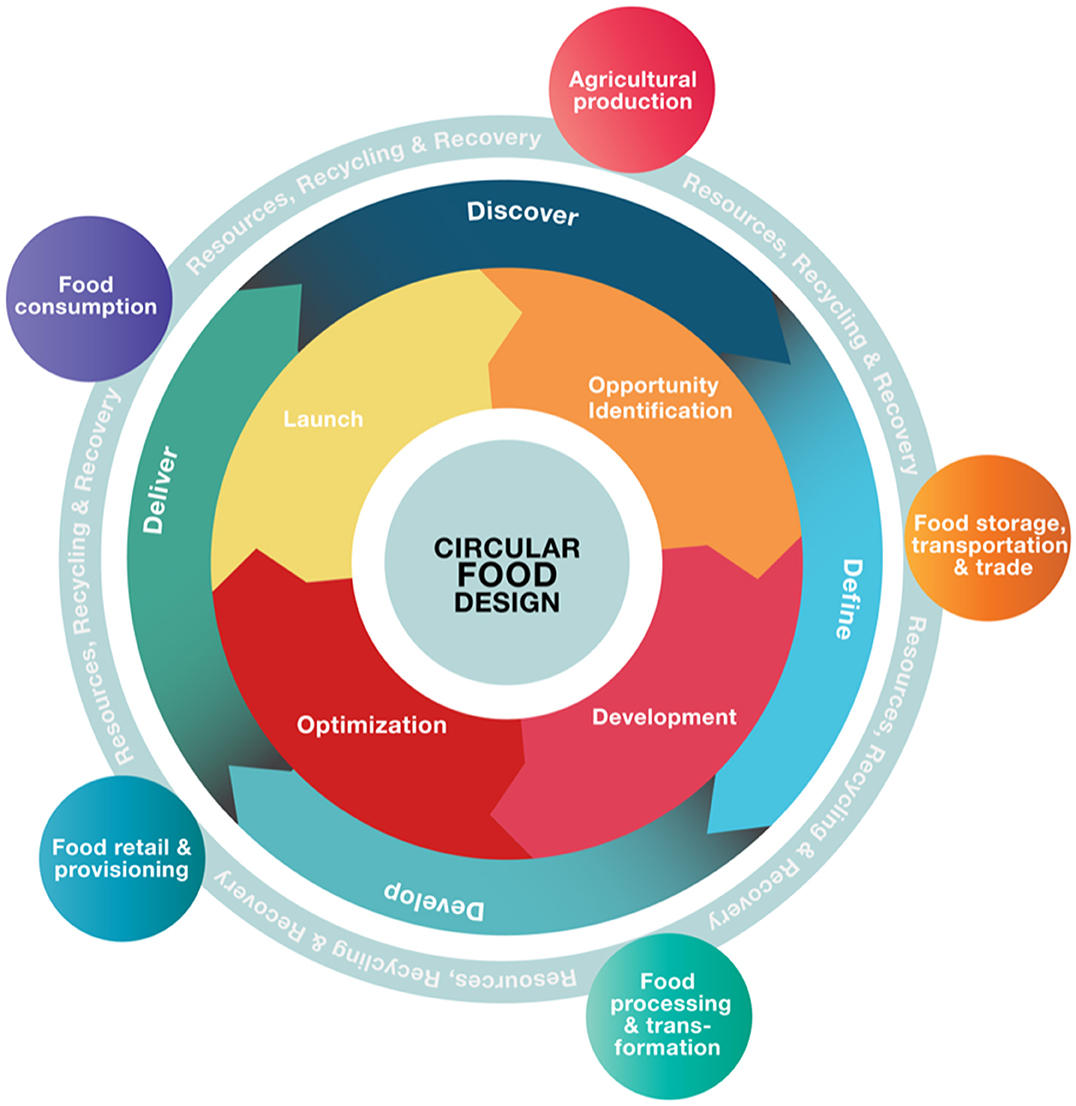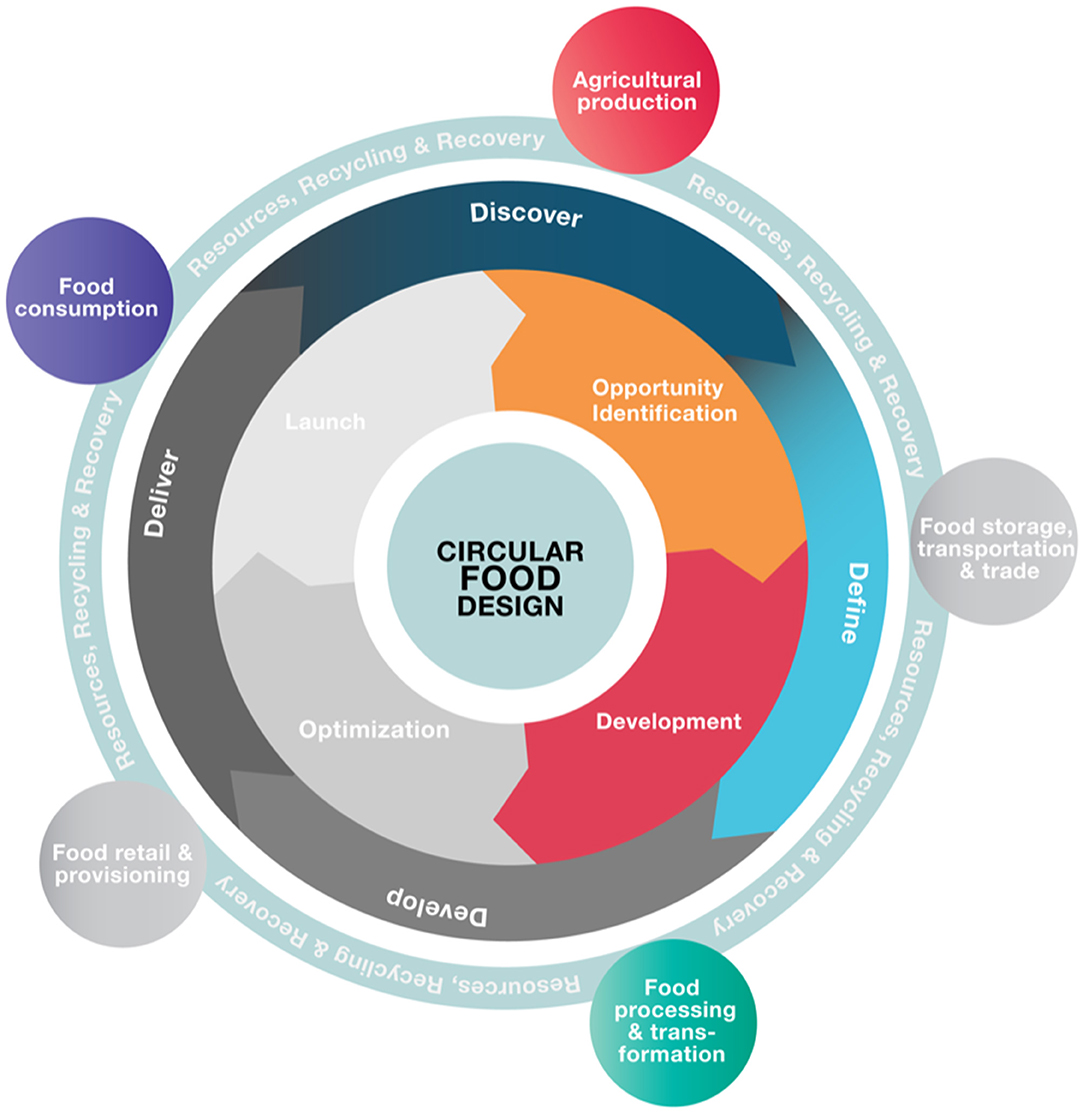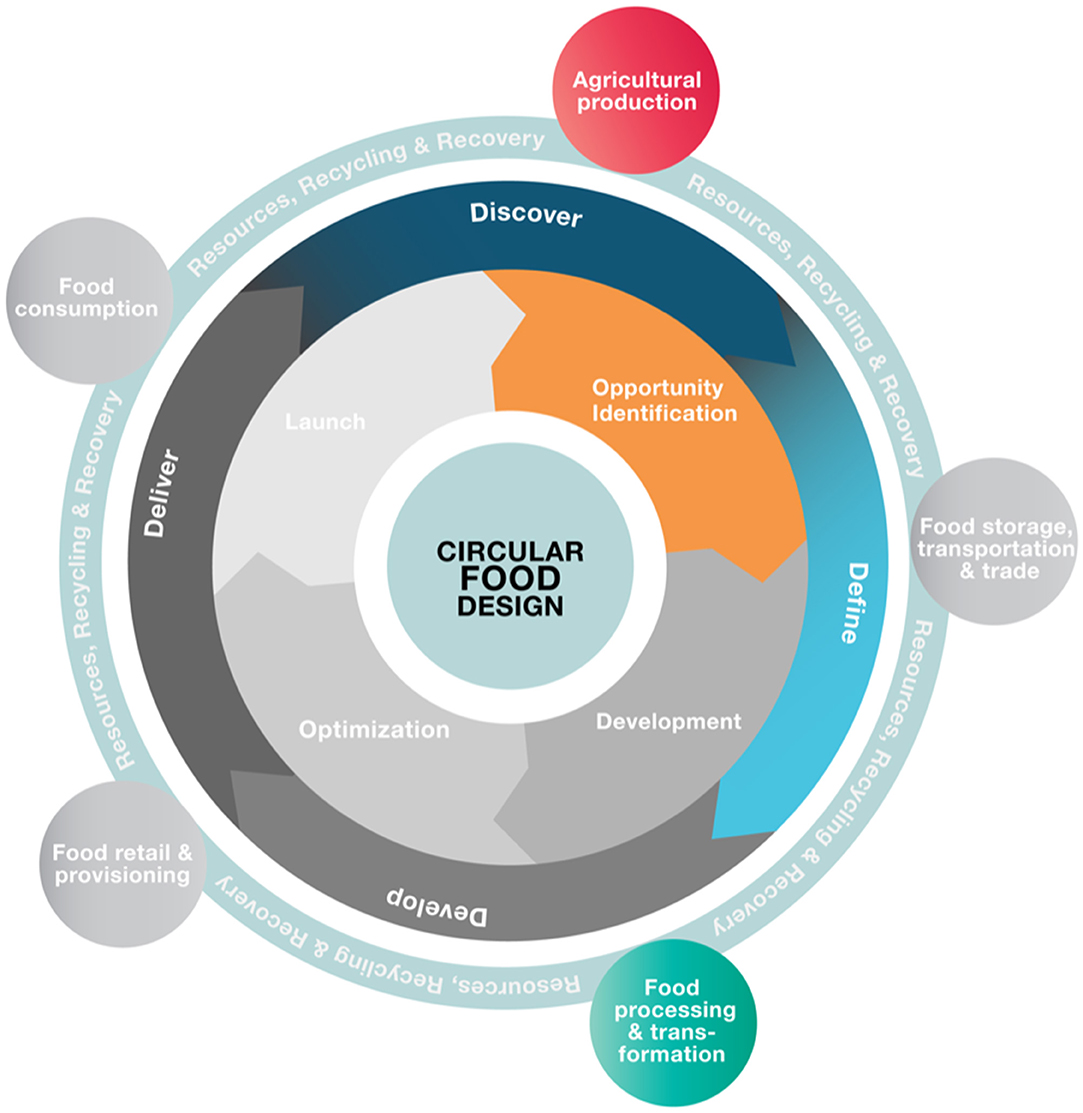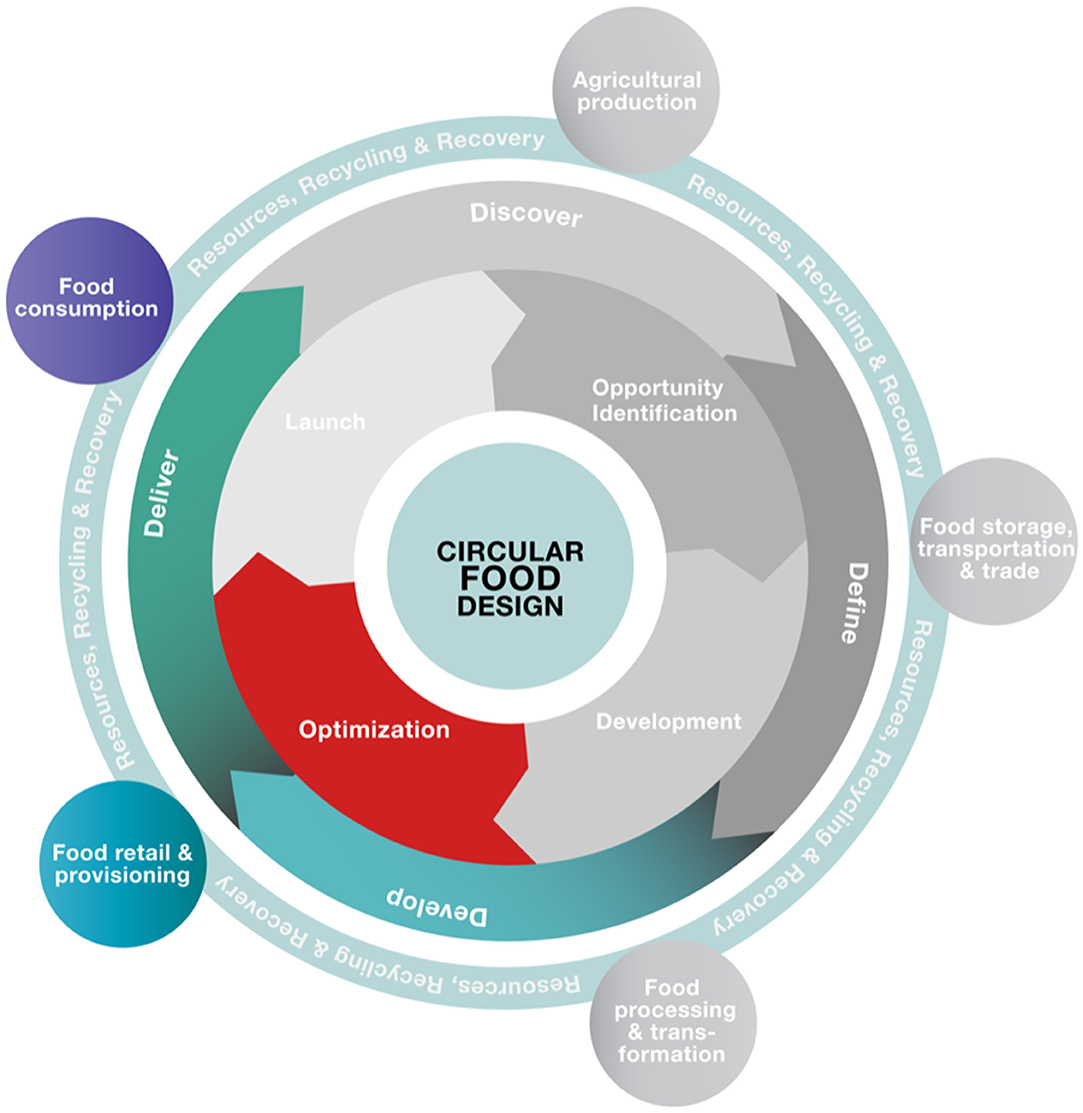- 1Wageningen Economic Research, Wageningen University & Research, Wageningen, Netherlands
- 2Food Quality and Design, Wageningen University & Research, Subdivision, Wageningen, Netherlands
- 3Studio Madelinde Hageman, Amsterdam, Netherlands
Innovations are urgently required to transform toward a more circular food system in which the food production and processing is more sustainable and the dietary patterns of consumers are more healthy and sustainable. It is needed to be more innovative in a multidisciplinary and consumer oriented way. Therefore, this paper introduces circular food design model and presents some applications. This paper presents background information regarding relevant models of product development and combines approaches and insights from different disciplines, such as consumer and food science, all present in the food system. In addition, the linkage with design thinking is addressed. Moreover, research questions are presented focused on the identification, development and optimization phase with regard to agricultural production, food storage, processing, retail and consumption. This circular food design model can support a way of thinking that will lead to multidisciplinary and citizen participating in food product development. The added value of circular food design model is; first, the model stimulates a citizen participation approach in a creative way; second, the model supports communication and collaboration among all involved disciplines. The newly developed circular food design model visualizes an iterative approach meant to be a flexible and creative tool to structure the new food development in the different phases to support value creation in the food system in order to support its transition.
Introduction
Increasing dynamics and complexity of the world in general, as well as the food system, specifically, demonstrate the need for more flexible food innovation in order to become more sustainable and healthy. The importance of food innovation has been an important issue for centuries. Starting with the twentieth century, food innovation has changed from a perspective of scarcity followed by a health perspective to that of a more sustainable food system and dietary pattern at present. The position of consumer acceptance of food innovation has become more relevant during times of abundance; thus, in recent decades, a transition from market push toward market-driven, consumer-oriented and even co-creation has occurred (Grunert and van Trijp, 2014; Saguy and Taoukis, 2017). User-oriented innovation is defined as a process toward the development of a new product or service in which an integrated analysis and understanding of the users' desires, needs and preferences play a key role (Grunert et al., 2008). Addressing the consumer started in the 1990s with the publications of a consumer-oriented approach by Jongen and Meulenberg (1998), Linnemann et al. (1998), Sijtsema et al. (2002), Linnemann et al. (2006), Grunert et al. (2008), and Moskowitz and Hartmann (2008). The need of consumers involvement is also addressed in current studies about Circular Economy (Heidbreder et al., 2019). The relevance of addressing the consumer in the circular economy is also made by Muranko et al. (2018). They developed the Pro Circular Change Model in which they perfectly address consumers characteristics such as pro-circular values, behavioral intentions such as attitudes, norms and control as well as behavioral change interventions. Their model represents the consumer but these insights are of value even more if they are involved in the design of food. Moreover, Camacho-Otero et al. (2018) state that publications about the integration of users and consumers into the design process are rare. This study adds to this from a food system perspective in order to support innovations not only for consumers but also with consumers in the design process of food.
Bringing disciplines in-line with consumers' needs and wishes is also a notable issue in the world of design. Design experts have developed techniques and practices to address open, complex, dynamic and networked problems (Dorst, 2015), such as design thinking. This approach makes it possible to think about and link consequences, such as wishes, needs or values, to items, such as design objects, systems, services or concepts, and working principles, such as functionality (Dorst, 2015), Design thinking is a structured way of thinking applied in design activities that use designer's methods to match people's needs with what is technically feasible and commercially viable (Brown, 2008). That design thinking is also relevant for food innovation addresses Olsen (2015). She describes the background of design thinking and proposes that design thinking is a learning approach for innovation that needs to be discussed, improved and tested within the food domain in order to support food development with more interaction and communication among the different disciplines and quicker actions with an eye on consumer empathy (Olsen, 2015). According to Olsen (2015), there are three specific aspects capturing the core of Design Thinking: First, consumer empathy by means of interacting with users in all phases. Second, visualization and rapid prototyping, and third, collaboration such as co-creation and interaction with different disciplines. We agree with Olsen (2015) that design thinking will be helpful for food innovations toward circular economy and further exploration is needed.
To date, the food innovation process or funnel has been presented as a linear process, but in a rapidly changing world, a circular process is needed, one that represents an iterative process. Our paper supports the approach of Olsen and further elaborates on it by presenting a circular food design approach in food system perspective. The aim of this paper is to introduce Circular Food Design model and present some applications. Applications are given regarding how design thinking can be combined with consumer involvement and participation in the form of research in different phases of food innovation with regard to food system elements such as production, processing and consumption.
This paper presents background information regarding relevant models of product development and combines approaches and insights from different disciplines, such as consumer and food science, all present in the food system. Of which we especially focus on food processing and transformation, food retail and provisioning and food consumption. In addition, the linkage with design thinking is addressed and presented in a model that will be explained by applications. Moreover, research questions are presented focussed on the identification, development and optimization phase for the different elements of the food system such as agricultural production, food processing and food consumption. This Circular Food Design model can support a way of thinking that will support multidisciplinary, citizen participation in food product development as part of food system transition.
Background
Food System and New Product Development
Nowadays there are numerous examples of failure in NPD in the food domain. Often, this failure is due to the mistaken assumption that technological innovations indubitably lead to products with interesting health or sensory characteristics that will be positively viewed by consumers (Dijksterhuis, 2016). This is even more relevant when this product development process is considered to be part of the current food system which consists of 5 elements of food supply system e.g., agricultural production, food storage, transport and trade, food processing and transformation, food retail and provisioning and food consumption (Van Berkum et al., 2018). Moreover, developing toward a more circular food system environmental drivers such as minerals, climate, water, biodiversity, fossil fuels, land and soils should be taken into consideration (Van Berkum et al., 2018).
Above issues show that in order to involve consumers in food product development also interaction with engineers is needed. That is exactly why Saguy and Taoukis (2017) state that food engineering is faced with a plethora of demanding challenges such as partnerships, creativity, multidisciplinarity, entrepreneurship, sustainability, health and nutrition. These researchers state that a paradigm shift is needed in food engineering. Below a tool is presented that describes how food engineers could cooperate in NPD in regards to multidisciplinary teams and increased creativity from food system perspective.
Consumer Research Point of View
For decades, a linear way of thinking has been represented in different phases of product development. This approach was defined via the opportunity identification phase, the development phase, and the optimization and launch phase (Van Kleef et al., 2005). The opportunity identification phase consists of different methods, such as the understanding consumer needs methods, creativity enhancement techniques and screening techniques. The aim of this phase is to explore and understand consumers' perception of the product in their everyday life. In addition to that, by means of creativity enhancement techniques, input should be provided for possible solutions. The next step has to be the screening of these possible solutions. When further developing a product planning tools, such as Quality Function Deployment, are helpful. Before launch, several rounds of optimization by means of product testing are needed. This process of product development is also described in the consumer-oriented stage gate process by Grunert and van Trijp (2014) (Figure 1). In this process consumer needs are combined with technological opportunities in the same four phases as Van Kleef et al. (2005) has given in this linear model. In addition, this model perfectly shows the necessity for interaction between different disciplines of technology and marketing and consumer research. Grunert and van Trijp (2014) describe that integration or consumer orientation is a challenging task that requires close interaction between the technological and marketing/consumer science capabilities within the company. Thus, in development of new products the consumers' point of perspective has to be included. In addition interaction between the different involved disciplines needs attention.
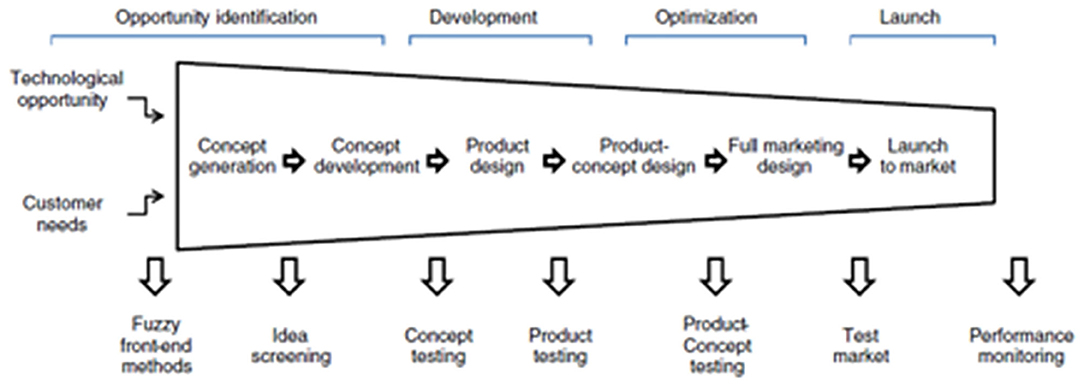
Figure 1. The formal gate way process of NPD (Grunert and van Trijp, 2014).
Participation, Open Innovation, Co-creation and Participation
In order to be more successful in food product development (Moskowitz and Saguy, 2013) stated that several of the most salient innovations include dealing with different groups and networks that exist both inside and outside the corporation (e.g., open innovation, partnerships), improved processes (e.g., stage gate processes), new ways of innovating (e.g., crowdsourcing), and an intimate understanding of the business processes. Crucial in this case is how often and in what way the consumer or end-user is involved during the innovation process. For example, the review of Bigliardi and Galati (2013) finds four different models of open innovation. In two of these the consumers are part of the knowledge exchange and in the other two, they are not. These open innovation models link with the concept of customers' co-creation (Prahalad and Ramaswamy, 2003). Co-creation shows the process and integration of several aspects as well as the importance of communication between the different disciplines present in product development. Generally co-creation is considered a method of cooperation in which new solutions are developed toward an idea or wish and by a group of people having different disciplines and backgrounds that include the end users or consumers. It is an open, active, and creative process in which added value is created between idea providers, people who are also thinking about this problem, end users and other interested people Ehlen et al. (2017).
Publications about the application of co-creation of food are rare. To the best of our knowledge, Filieri (2013) presents the first co-creation example for food in the early phases of NPD. Their paper concludes that customers or consumers freely provide valuable, original, new, and feasible ideas that can foster product and service innovation and may trigger process innovation. This study illustrates how a food company has used the ideas gathered from customers to develop new products and services. The most intriguing aspect is that a consumer suggestion elicited a technology innovation (steam cooking of biscuits) that was adopted for the first time in the field. It also shows the company has gathered strategic information about consumers' needs and desires. Finally, this study discusses the importance of knowledge and transparent communication. Another more recent example from Jacobs (2015) explores co-creation for chips in a multidisciplinary perspective (e.g., marketing, heritage studies and history) and shows that knowledge, reflexivity and insight to be gained at their intersection is of added value. These co-creation studies show the relevance of considering insights from several disciplines as well as consumer inclusion.
Design Thinking
To date, the new product development was mainly described as a linear process, but since the interaction between different disciplines and integration of the consumer became increasingly important, one can now speak of continuous or iterative product development (e.g., co-creation, co-innovation or co-design). The domain of food can learn from this approach that innovation is a process in which interaction between disciplines is needed and should be a circular approach (Schneider and Stickdorn, 2010). Supporting and structuring this interaction between different disciplines is a process familiar in the world of design and recognized in design-focused literature. Design Thinking has been defined as “a human centered innovation process that emphasizes observation, collaboration, fast learning, visualization of ideas, rapid prototyping, and concurrent business analysis” (Lockwood, 2010). Design thinking is able to break large problems into smaller pieces resolved via a practical stepwise approach, for example via the Double Diamond Model of the British Council (Tschimmel, 2012) presented in Figure 2. The concept considers divisions between problem, problem definition and solution. This Double Diamond design process model is graphically based on a simple diagram describing the divergent and convergent phases of the design process that gives the model the form of a double diamond.
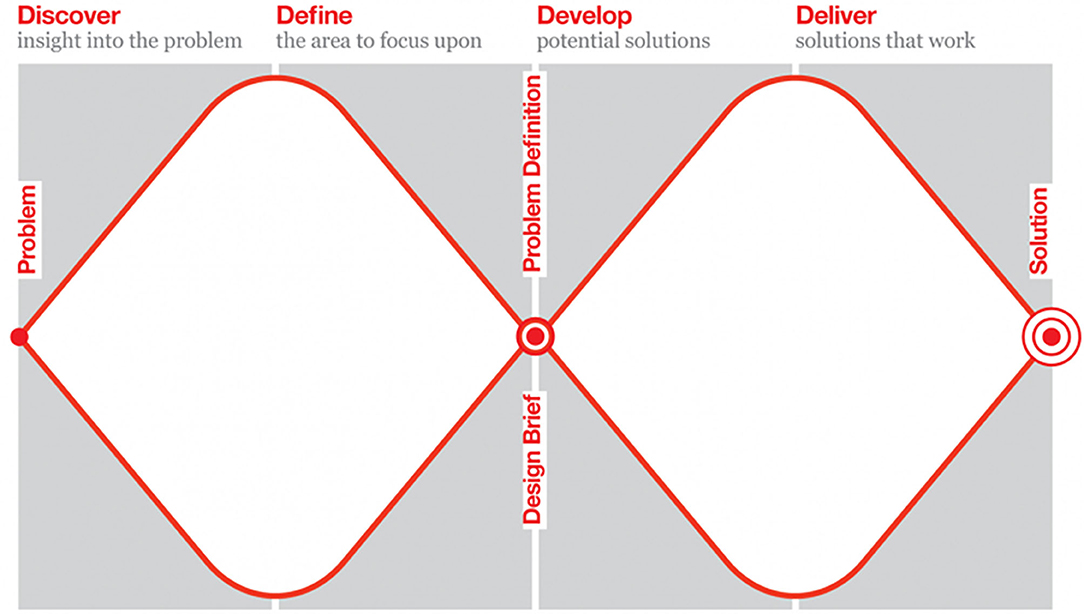
Figure 2. Double diamond model (Tschimmel, 2012).
Designing is a dualistic approach in which both problem and solution need to be explored. This dualistic approach is also represented in the 4D model. The design starts with exploring the problem to find inspiration for ideas and potential solutions and turning these ideas into tangible sketches or prototypes, in several steps back and forward. In this way, designers learn quickly about the problem and solution in order to review and re-examine it until there is a distinct match between problem and solution. This design is a process of two steps forward, one step back in which visualization, learning and transformation are key.
The double diamond model is also called the 4D model because the name of each phase starts with a “D”:
Discover—search for new opportunities, markets, processes and the like, in daily life and literature via methods such as research. In this phase the actual problem that has to be solved, has to be defined. Generally, the problem is linked to how to come up with more healthy and/or sustainable foods. The aim is to explore and better understand consumer behavior and attitudes and the possibilities of products, co-products, processes, ingredients, packaging, and or distribution.
Define—to select first insights, in order to demarcate the topic and redefine it. Get insights into possibilities for technologies of processing, products, ingredients and packaging based on testing. These insights might help to demarcate the options of type of products, target groups, product characteristics, distribution channel. Selection is done based on insights from the different disciplines involved.
Develop—solutions are developed, iterative refined and tested in multidisciplinary teams. Development of samples/concepts with different processing, types of ingredients, packaging, target groups and the like. For example by means of sensory research. Based on the development and testing of these with experts and consumers, the results will guide to define which products and ingredients are more appreciated and optimize the options even more.
Deliver—the final prototype (thus the food product, package and associated distribution and communication) is tested, produced and launched. Thus, the full concept is available, including the processing chain and locations of availability.
According to Olsen (2015), design thinking should also be relevant for the food innovation process. To search for a solution to the problem in the case of a new or improved food or package, it is usually needed to repeat the different phases of discovery and refine elements of the product in the food system context. That includes, for example, the choice of technology, way of production and distribution, the particular product and its ingredients, the concept of full product and package, rest streams or co-products, disposal and associated communications and marketing. For example, in the Define phase participants choose e.g. types of products and processing technologies, ingredients, distribution channels after which another part e.g., ingredients and type of packaging of the concept will be developed.
Circular Food Design Model
The Circular Food Design model combines the aims of the different product development phases from consumer research, food system and design thinking point of view. This model, presented in Figure 3, addresses the fact that there are several possible combinations of the four phases (opportunity identification, development, optimization and launch) with the food supply system perspectives considering agricultural production, food storage, transport and trade, food processing and transformation, food retail and provisioning and food consumption. From sustainability point of perspective within food system there should be attention to be efficient with resources, recycle, and support waste recovery. In addition to these, the elements of the design thinking approach with its 4 Ds (discover, define, develop and deliver) need to be included. What is included depends on if you are dealing with incremental or rigorous innovations and if a concept is available. Below we explain this model based on several studies done last decades.
This circular food design model is meant to support and structure the development process in the food system perspective. In practice, it is not always necessary to start with opportunity identification. Depending on the concept or product available, one could also start in the development stage. Ideally, to avoid misunderstandings, the consumer perspective is taken into consideration immediately. To answer the different questions in each phase, several methods are available. In the above example group discussions, surveys, and sensory consumer research are applied. In addition, creativity was used in regard to the way questions were discussed via means of visualization or association both in workshops with experts or with consumers. In this way, exploring relevant issues is both more attractive to participants and provides more abundant data. The model supports structuring the questions in the different phases. Table 1 presents the questions to be asked in the different phases to find solutions that will work best from a health and sustainability perspective.
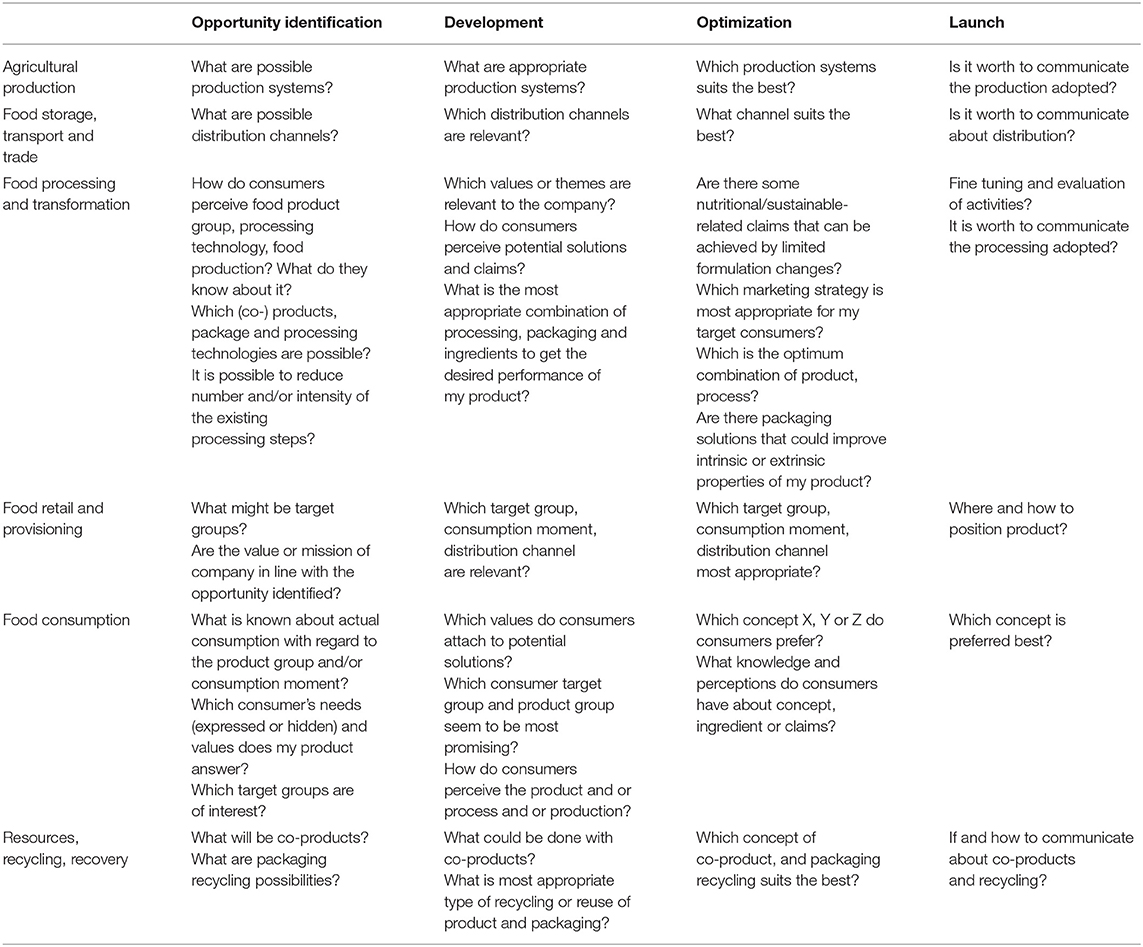
Table 1. Examples of questions of the different food system elements and the 4 phases of product development in circular food design.
Description of the Model by Means of Applications
Below some examples are given which each show a different combination of stages, food system elements and one or more D's. During opportunity identification and development, problem orientation is central therefore mainly discovering and define take place, while optimization and launch is more solution oriented and develop and deliver methods should be applied.
Application: Too Much Fruit, Too Little Consumption
In order to stimulate fruit consumption possibilities of dried fruit were identified, dealing with food consumption, agricultural production and food processing. In the opportunity identification phase possibilities of processing technologies of drying were explored, the type of product such as strawberries, cherries or black currents had to be chosen and consumers needs and perceptions discovered. Based on literature as well as group discussions consumers' needs, wishes and perceptions of dried fruit were explored (Jesionkowska et al., 2007). In this qualitative study, consumers' ideas and associations of dried fruit in general were discovered by means of projective techniques, which trigger participants creativity. Other techniques, such as the repertory grid, were applied to gather ideas and obtain possible solutions concerning dried fruit products and about which products dried fruit could be added to. In this opportunity identification phase, comparable products already on the market were explored to help visualize and discuss product characteristics. Additionally, the technological possibilities were explored by means of discovering the possibilities and restrictions of conventional and freeze-drying of fruits. These consumers and technological insights were exchanged within the team of experts from different disciplines. Further discovering and defining of the product was supported via a quantitative consumer study (Jesionkowska et al., 2009) that provided deeper insight into the consumption of several dried fruits (e.g., raisins, dates, and figs) and products containing dried fruits (e.g., cereals, cookies, and tea). Based on these consumption insights from quantitative consumer research, it was learned that dried fruit added to other products might reach more people than dried fruit on its own, especially in the Netherlands and France. Thus, these consumption insights together with technological explorations made the multidisciplinary team to choose conventional drying, because the concepts of dried fruits seem more appropriate to add to product groups, such as cereals or biscuits. In the development phase different types of fruits were dried, tested and potential concepts were judged based on preliminary taste testing. Taste and health benefits were criteria chosen within the team to be included in workable concepts and therefore black currant and sour cherry were selected as the types of fruit with the greatest potential. During this development phase, the conventional drying conditions were optimized and different potential osmotic agents such as sucrose, apple juice and inverted sugar were tested. Thus, several concepts for different types of fruit and different osmotic agents were developed (Konopacka et al., 2009). For example, the selection of the type of fruit as well as the osmotic agents were discussed in a workshop during which the insights from both consumer studies perspectives and processing tests were exchanged between experts to help them make the best choices and prepare the optimization phase. Figure 4 presents the different phases and food system elements taken into consideration during discovering and defining.
Application: Exploring Bio-Based
As part of circular economy the use of renewable resources for packaging of food recently got more attention in terms of more efficient use and recycling of resources. During opportunity identification exploration of consumers perception of bio-based is needed therefore associations with bio-based as term and different bio-based products is studied (Sijtsema et al., 2012). Creative group discussions gave insight in, or in other words discovered, consumer ambivalent feelings about bio-based as a concept and motives and barriers with variety of bio-based products and whether it is applicable for all products/companies or not. Those insights were quantitatively tested in a survey for a representative sample, which helped to define those characteristics most relevant for further development. Companies should be aware of consumers their ambivalent feelings which need further attention (Onwezen et al., 2012). Moreover, Reinders et al. (2017) show that attitudes toward a brand are influenced by the actual amount of bio-based. These consumer insights are of value for companies who develop or apply bio-based products or packaging. Figure 5 presents this application in the opportunity identification phase for two food system elements in discovering and defining.
Application: Targeted Interventions
To optimize a solution which aims to increase fruit and vegetable consumption, target groups are created based on consumption of fruit and vegetables and health related motive orientations. This is presented in Figure 6. During the optimization phase product characteristics are developed and delivered and based on these interventions or communications strategies are developed for the different target groups (Raaijmakers et al., 2018). In order to support the multidisciplinary discussion between experts such as breeders and growers and consumer research results of the consumer studies were visualized (Labrie and Sijtsema, 2018). It was up to the experts themselves to apply the insights in the innovation process for the launch of a specific type of fruit or vegetable for a specific target group.
The above applications show the multidisciplinary character for innovation in food system such as dried fruit, bio-based packaging and interventions for target groups. Types and varieties of products, processing, different ingredients and technologies as well as efficient use of resources were chosen based on combining consumer insights and technological explorations. The above cases show the value of the iterative process, the different steps of design thinking and how these steps were applied to the different phases of product development. This approach also shows that it is a stepwise process in which discover and define as well as develop and deliver are continuous, going back and forth considering choices for products, processing, ingredients, packaging and other items, such as distribution, claims, or waste recovery. The above applications show that depended on the starting position the model can be applied flexible.
Discussion
Beyond the linear approach of new food product development, we propose a circular food design that takes a multidisciplinary approach and stimulates interaction with citizens through all phases of product development in a food system perspective. In this user-centered approach their associations, experiences, attitudes, values of products, production, processing, packaging, labeling and claims are explored in a more creative and iterative way.
Circular food product design has the following characteristics with regard to the food system and citizen point of perspective. First, not only the product itself but daily life experiences of consumers as represented by specific moments, situations, habits, routines, traditions or values will be considered. In addition, consumer perception and acceptance of the technology applied during production and processing should be taken into consideration. Second, by means of qualitative (e.g., interviews, groups discussions, customer journey, diary) and quantitative (e.g., surveys, experiments or interventions) as well as participatory methods and workshops, citizens are involved in the process. Exposing the citizens to technological possibilities and attempting to understand their perception of technological innovations in the food system is needed. Tools and methods applied should not only consider the rational consumer but also include the irrational behind their behavior by means of the use of pictures or drawings intended to stimulate the imagination. The application of projective techniques is helpful in this (Jesionskowska et al., 2008; Sijtsema et al., 2016). Applied in the case of health, these techniques can find perceptions of food showing irrational associations, emotions, needs and wishes (Sijtsema et al., 2002). Finally, while integration of consumer input is needed, they can have different roles, from reflective or consultative in a user-oriented or consumer-oriented approach to a full participatory role in co-creation. Overall, this approach means, in the words of Tschimmel (2012), “designing with users in a human centered approach, instead of for users in former times.”
The large risk associated with technology-driven innovation in food products lies in the subtle conflict between the consumers being uninformed and therefore having an ambivalent attitude toward food and its production and processing that might lead to a negative perception of the innovation. In this respect, tailoring the technological innovation to the consumers' need is the key to a successful design of new products.
Circular Food Design also supports interaction between different disciplines. The Circular Food Design model is developed to show that both food and consumer science should come together in a circular, iterative and concentric approach that combines insights from different disciplines in each phase. First, the need for this approach is also stressed by Saguy and Taoukis (2017), who state that food engineers of the future will have the additional responsibility of addressing entirely new topics and dimensions, such as innovation, partnerships, creativity, entrepreneurship, sustainability, social responsibility, population growth, and aging. The Circular Food Design model will help to identify the different phases and related questions and structure the different variables and testing assumptions. Second, in order to support the communication between disciplines in this process Jacobsen et al. (2014) developed a useful framework in the EU project CONNECT4ACTION that explains the internal and external communication performed during the different phases of product development. Examples of this multidisciplinary cooperation are presented in Bertschinger et al. (2009). Third, creativity is not only helpful in consumer research Linnemann et al. (2006) but also helpful when transforming ideas, insights, and observations into product characteristics, concepts or prototypes by making use of drawing, images and in working toward prototypes. This creativity is also needed, since the majority of available methods and techniques to be applied in early phases of NPD are not used at all by companies or only applied in an ad hoc manner (Mahajan and Wind, 1992; Nijssen and Lieshout, 1995; Nijssen and Frambach, 2000; Van Kleef et al., 2005). These researchers determine that in most cases, focus groups, surveys and the study of demographic data are used instead. Therefore, the success rates for new products is relatively low (Wind and Mahajan, 1997). Thus, there is a need for more accurate application of methods and techniques to integrate into new product development to improve it. The Circular Food Design model stimulates creative method application helpful to product development. Fourth, the applications described only show one or a few steps in one or two phases of the innovation. The choice for a circular model also wants to represents that it should be an iterative process. Which means that the next steps to further improve the concept will show that feedback loops of different issues such as the product itself, its taste, it's packaging as well recycling options of the package might be taken into consideration in the next phase. This also means that again different disciplines should bring their questions and insights together in order to create a continuous process of innovation.
In its current form the model is developed based on insights and experiences of processing and transformation, food retail and provisioning, and food consumption in Europe. In future applications it will be also relevant to take agricultural production into consideration, which is confronted with the following four key challenges in EU: resource efficiency of food systems, enhancing resilience, protecting and improving social wellbeing and responsible and effective governance (EEA, 2017). For example development of innovative agricultural production systems toward circularity might make use of this way of thinking. Moreover, in the transformation toward a more sustainable food system especially resources, recycling and recovery needs attention.
Next, concerning these issues, legislation regarding new food ingredients, such as insect protein, has to be taken into consideration, as well as legislation regarding claims or the application of new technologies.
Concluding Remarks
The model is meant to be a tool to structure and combine the different perspectives and phases of innovation in food system in order to be more iterative, creative and successful in healthy and sustainable food development.
The added value of circular food design model consists of supporting communication and collaboration among all involved disciplines, stimulating citizen involvement and participation. This approach includes adding visualization and creativity to the transformation and prototyping process, stimulating internal and external communication and includes interaction with the consumers during all phases.
Data Availability Statement
The original contributions presented in the study are included in the article/supplementary material, further inquiries can be directed to the corresponding author/s.
Author Contributions
SS, VF, and MH contributed to the design of the model and the writing of the manuscript. All authors contributed to the article and approved the submitted version.
Funding
Part of the work leading to this article was carried out in the Connect4Action project with the financial support of the European Commission (289023) under the Food, Agriculture and Fisheries, and Biotechnology Theme for the 7th Framework Programme for Research and Technological Development.
Conflict of Interest
The authors declare that the research was conducted in the absence of any commercial or financial relationships that could be construed as a potential conflict of interest.
Acknowledgments
The authors gratefully acknowledge the support of Karin Zimmermann of Wageningen Economic Research in the former phase of this project.
References
Bertschinger, L., Corelli-Grappadelli, L., Derkx, M. P. M., Hall, S., Kockerols, K., Sijtsema, S. J., et al. (2009). A search for a systematic method to bridge between pre-harvest, post-harvest, and consumer research aimed at increasing fruit consumption: the “Vasco da Gama” process. J. Hortic Sci. Biotechnol 84, 2–6. doi: 10.1080/14620316.2009.11512586
Bigliardi, B., and Galati, F. (2013). Models of adoption of open innovation within the food industry. Trends Food Sci. Technol. 30, 16–26. doi: 10.1016/j.tifs.2012.11.001
Camacho-Otero, J., Boks, C., and Pettersen, I. N. (2018). Consumption in the circular economy: a literature review. Sustainability 10:2758. doi: 10.3390/su10082758
Dijksterhuis, G. (2016). New product failure: five potential sources discussed. Trends Food Sci. Technol. 50. 243–248. doi: 10.1016/j.tifs.2016.01.016
Dorst, K. (2015). Frame Inovation: Create New Thinking by Design. Massachusetts: The MIT Press. doi: 10.7551/mitpress/10096.001.0001
EEA (2017). Food in a Green Light. A Systems Approach to Sustainable Food. EEA Report no 16/2017. European Environment Agency; MIT Press.
Ehlen, C., van der Klink, M., Stoffers, J., and Boshuizen, H. (2017). The Co-Creation-wheel a four-dimensional model of collaborative, interorganisational innovation. Eur. J. Train Dev. 41, 628–646. doi: 10.1108/EJTD-03-2017-0027
Filieri, R. (2013). Consumer co-creation and new product development: a case study in the food industry. Mar. Intell. Plann. 31, 40–53. doi: 10.1108/02634501311292911
Grunert, K. G., Jensen, B. B., Sonne, A. M., Brunso, K., Byrne, D. V., Clausen, C., et al. (2008). User-oriented innovation in the food sector: relevant streams of research and an agenda for future work. Trends Food Sci. Technol. 19, 590–602. doi: 10.1016/j.tifs.2008.03.008
Grunert, K. G., and van Trijp, H. C. M. (2014). Consumer-oriented new product development. Encycl. Agric. Food Syst. 2, 375–386. doi: 10.1016/B978-0-444-52512-3.00062-0
Heidbreder, L. M., Bablok, I., Drews, S., and Menzel, C. (2019). Tackling the plastic problem: a review on perceptions, behaviors, and interventions. Sci. Total Environ. 668, 1077–1093. doi: 10.1016/j.scitotenv.2019.02.437
Jacobs, M. (2015). Chips in black boxes? Convenience life span, parafood, brandwidth, families, and co-creation. Appetite 94, 34–39. doi: 10.1016/j.appet.2015.03.012
Jacobsen, L. F., Grunert, K. G., Sondergaard, H. A., Steenbekkers, B., Dekker, M., and Lahteenmaki, L. (2014). Improving internal communication between marketing and technology functions for successful new food product development. Trends Food Sci. Technol. 37, 106–114. doi: 10.1016/j.tifs.2014.03.005
Jesionkowska, K., Sijtsema, S. J., Konopacka, D., and Symoneaux, R. (2009). Dried fruit and its functional properties from a consumer's point of view. J. Hortic Sci. Biotechnol. 84, 85–88. doi: 10.1080/14620316.2009.11512601
Jesionkowska, K. K. D., Płocharski, W., Sijtsema, S., and Zimmermann, K. (2007). What do Polish and Dutch consumers think about dried fruit and products with them – creative group discussions as a mean of recognition consumers' perception. Polish J. Nat. Sci. (Suppl. 4), 169–175.
Jesionskowska, K. S., Simoneaux, R, Konopacka, D., and PŁocharski, W. (2008). Preferences and consumption of dried fruit and dried fruit products among Dutch French and Polish consumers. J. Fruit Ornamental Plant Res. 16, 261–274.
Jongen, W. M. F., and Meulenberg, M. T. G. (1998). Innovation of Food Production Systems: Product Quality and Consumer Acceptance. Wageningen: Wageningen Pers.
Konopacka, D., Jesionkowska, K., Klewicki, R., and Bonazzi, C. (2009). The effect of different osmotic agents on the sensory perception of osmo-treated dried fruit. J. Hortic Sci. Biotechnol. 84, 80–84. doi: 10.1080/14620316.2009.11512600
Labrie, C. W., and Sijtsema, S. J. (2018). Flavour-Driven Marketing of Fruits and Vegetables: Market Segmentation of Consumers Based on Lifestyle. Wageningen: University and Research, p. 6.
Linnemann, A. R., Benner, M., Verkerk, R., and van Boekel, M. A. J. S. (2006). Consumer-driven food product development. Trends Food Sci. Technol. 17, 184–190. doi: 10.1016/j.tifs.2005.11.015
Linnemann, A. R., Meerdink, G., Meulenberg, M. T. G., and Jongen, W. M. F. (1998). Consumer-oriented technology development. Trends Food Sci. Technol. 9, 409–414. doi: 10.1016/S0924-2244(99)00006-0
Lockwood, T. (2010). Design Thinking. Integrating Innovation, Customer Experience, and Brand Value. New York, NY: Allworth Press.
Mahajan, V., and Wind, J. (1992). New product models: Practice, shortcomings and desired improvements. J. Pro. Inno. Manag. 9, 128–139. doi: 10.1016/0737-6782(92)90004-V
Moskowitz, H., and Hartmann, J. (2008). Consumer research: creating a solid base for innovative strategies. Trends Food Sci. Technol. 19, 581–589. doi: 10.1016/j.tifs.2008.01.016
Moskowitz, H. R., and Saguy, I. S. (2013). Reinventing the role of consumer research in today's open innovation ecosystem. Crit. Rev. Food Sci. Nutr. 53, 682–693. doi: 10.1080/10408398.2010.538093
Muranko, Z., Andrews, D., Newton, E. J., Chaer, I., and Proudman, P. (2018). The pro-circular change model (P-CCM): proposing a framework facilitating behavioural change towards a circular economy. Resourc. Conserv. Recycl. 135, 132–140. doi: 10.1016/j.resconrec.2017.12.017
Nijssen, E. J., and Frambach, R. T. (2000). Determinants of the adoption of new product development tools by industrial firms. Indus. Mark Manag. 29, 121–131. doi: 10.1016/S0019-8501(98)00043-1
Nijssen, E. J., and Lieshout, K. F. (1995). Awareness, use and effectiveness of models and methods for new product development. Eur. J. Marketing. 29, 27–44. doi: 10.1108/03090569510098483
Olsen, N. V. (2015). Design thinking and food innovation. Trends Food Sci. Technol. 41, 182–187. doi: 10.1016/j.tifs.2014.10.001
Onwezen, M. C., Reinders, M. J., Sijtsema, S. J., van der Lans, I. A., Jasiulewicz, A., Dolors Guardia, M., et al. (2012). A cross-National consumer segmentation based on food benefits: the link with consumption situations and food perceptions. Food Qual. Preference 24, 276–286. doi: 10.1016/j.foodqual.2011.11.002
Prahalad, C. K., and Ramaswamy, V. (2003). The new frontier of experience innovation. Mit Sloan Manage. Rev. 44:12.
Raaijmakers, I., Sijtsema, S., Labrie, C., and Snoek, H. (2018). Consumer segmentation based on health-related motive orientations and fruit and vegetable consumption. Br. Food J. 120, 1749–1763. doi: 10.1108/BFJ-02-2018-0098
Reinders, M. J., Onwezen, M. C., and Meeusen, M. J. (2017). Can bio-based attributes upgrade a brand? How partial and full use of bio-based materials affects the purchase intention of brands. J. Clean. Prod. 162, 1169–1179. doi: 10.1016/J.JCLEPRO.2017.06.126
Saguy, S., and Taoukis, P. S. (2017). From open innovation to enginomics: paradigm shifts. Trends Food Sci. Technol. 60, 64–70. doi: 10.1016/j.tifs.2016.08.008
Schneider, J., and Stickdorn, M. (2010). This is Services Design Thinking. Amsterdam: BIS Publishers.
Sijtsema, S., Linnemann, A., van Gaasbeek, T., Dagevos, H., and Jongen, W. (2002). Variables influencing food perception reviewed for consumer-oriented product development. Crit. Rev. Food Sci. Nutr. 42, 565–581. doi: 10.1080/20024091054256
Sijtsema, S. J., Jesionkowska, K., Symoneaux, R., Konopacka, D., and Snoek, H. M. (2012). Perceptions of the health and convenience characteristics of fresh and driedfruits. Food Sci. Technol. 49, 275–281. doi: 10.1016/j.lwt.2012.04.027
Sijtsema, S. J., Onwezen, M. C., Reinders, M. J., Dagevos, H., Partanen, A., and Meeusen, M. (2016). Consumer perception of bio-based products—An exploratory study in 5 European countries. NJAS Wageningen J. Life Sci. 77, 61–69. doi: 10.1016/j.njas.2016.03.007
Tschimmel, K. (2012). “Design thinking as an effective toolkit for innovation,” Paper Presented at the Proceedings of the XXIII ISPIM Conference: Action for Innovation: Innovating From Experience (Barcelona).
Van Berkum, S., Dengerink, J., and Ruben, R. (2018). The Food Systems Approach: Sustainable Solutions for a Sufficient Supply of Healthy Food. Wageningen: Wageningen Economic Research, Memorandum. 2018–064. doi: 10.18174/451505
Van Kleef, E., Van Trijp, H. C. M., and Luning, P. (2005). Consumer research in the early stages of new product development: a critical review of methods and techniques. Food Qual. Preference 16, 181–201. doi: 10.1016/j.foodqual.2004.05.012
Keywords: co-creation, food product development, design thinking, circular food design, food system, multi disciplinary, visualization, creativity
Citation: Sijtsema SJ, Fogliano V and Hageman M (2020) Tool to Support Citizen Participation and Multidisciplinarity in Food Innovation: Circular Food Design. Front. Sustain. Food Syst. 4:582193. doi: 10.3389/fsufs.2020.582193
Received: 10 July 2020; Accepted: 03 November 2020;
Published: 27 November 2020.
Edited by:
Bálint Balázs, Environmental Social Sciences Research Group, HungaryReviewed by:
Yiching Song, Chinese Academy of Sciences (CAS), ChinaCornelia Butler Flora, Iowa State University, United States
Copyright © 2020 Sijtsema, Fogliano and Hageman. This is an open-access article distributed under the terms of the Creative Commons Attribution License (CC BY). The use, distribution or reproduction in other forums is permitted, provided the original author(s) and the copyright owner(s) are credited and that the original publication in this journal is cited, in accordance with accepted academic practice. No use, distribution or reproduction is permitted which does not comply with these terms.
*Correspondence: Siet J. Sijtsema, c2lldC5zaWp0c2VtYUB3dXIubmw=
 Siet J. Sijtsema
Siet J. Sijtsema Vincenzo Fogliano
Vincenzo Fogliano Madelinde Hageman3
Madelinde Hageman3